DD-823 History
The Beginning
It was inevitable that another Samuel B Roberts would soon join the fleet as a fitting tribute to the memories of both the man and the DE-413. That inevitability became reality in early 1945 when the Secretary of the Navy designated destroyer hull number 823 with the name Samuel B Roberts.
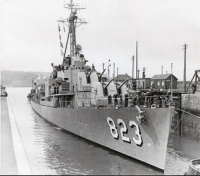 The second Samuel B Roberts was laid down on 27 June 1945 by the Consolidated Steel Corporation of Orange Texas. Launching occurred on November 30, 1945 and commissioning was on 22 December 1946. Sponsor of the vessel was Mrs. Samuel B Roberts, mother of the fallen hero. The new ship was commanded by Comdr. C.T. Doss. A copy of the invitation to the commissioning follows;
The second Samuel B Roberts was laid down on 27 June 1945 by the Consolidated Steel Corporation of Orange Texas. Launching occurred on November 30, 1945 and commissioning was on 22 December 1946. Sponsor of the vessel was Mrs. Samuel B Roberts, mother of the fallen hero. The new ship was commanded by Comdr. C.T. Doss. A copy of the invitation to the commissioning follows;
Spanning the Globe
Following shakedown training off Guantanamo Bay, Cuba in February 1947, Samuel B Roberts joined the Atlantic Fleet. She participated in Fleet maneuvers prior to proceeding to the Mediterranean in January 1948. Returning to the United States in June, she began another year of operations along our eastern coast. She then conducted her second tour of foreign duty, visiting northern Europe from May to September 1949. Roberts next participated in western Atlantic operations until March 1950 when she returned to the Mediterranean to join the 6th Fleet. She steamed back to the United States in October 1950. Following further operations in the western Atlantic and Caribbean, she got underway for Scotland on 10 September 1952 to join NATO forces in “Operation Mainbrace,” before proceeding to the Mediterranean to once again join 6th Fleet. Two months later, in November, she returned for further duty off northern Europe, and finally headed home, arriving in Newport on 29 January 1953. 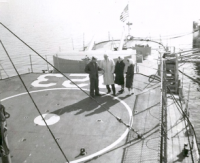
Samuel B Roberts operated in the Atlantic and Caribbean from early 1953 until 3 August 1954 when she headed for the western Pacific, via the Panama Canal, to begin an around-the-world cruise. She spent five months in the waters around Japan and the Philippines, then traversed the Indian Ocean, navigated the Suez Canal, and arrived home on 14 March 1955. The remainder of the year was spent in local operations with the exception of a hastily ordered voyage in July to a lifeguard station off Greenland during President Eisenhowers’s flight to Geneva.
Western Atlantic operations in early 1956 gave way to foreign duty when Roberts again joined the 6th fleet in the Mediterranean on 27 September. On 25 October, Roberts weighed anchor for the Persian Gulf and duty with the Middle East Force. She transited the Suez Canal on the nights of 27 and 28 October. She was the last warship through the Canal southbound before it was closed during the invasion of Egypt. The ship was then on duty with the Middle East Force until sailing home by way of Pakistan, India, East Africa, the Cape of Good Hope, and Brazil. Roberts arrived in Newport on 14 March 1957.
With the exception of a midshipman’s cruise to Rio de Janeiro, Samuel B Roberts remained near Newport until mid-September. She then participated in NATO exercises off northern Europe and returned to the United States on 22 October 1957.
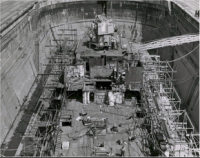 In March 1958, after a three-month overhaul, the destroyer moved into the Caribbean for refresher training. In May, the exercises were interrupted. Roberts deployed hastily to Venezuela and prepared to evacuate United States nationals following the violence during Vice President Nixon’s visit to South America. However, by the 15th the situation was under control. Roberts was relieved and she returned to Newport. Two months later, she was ordered to Morehead City, N.C., to rendezvous with amphibious units carrying Marine reinforcements to the Mediterranean during the Lebanon crisis. Roberts, with her squadron, Destroyer Squadron 10, escorted the amphibious units to Puerto Rico, whence the destroyers continued on to the Mediterranean.
In March 1958, after a three-month overhaul, the destroyer moved into the Caribbean for refresher training. In May, the exercises were interrupted. Roberts deployed hastily to Venezuela and prepared to evacuate United States nationals following the violence during Vice President Nixon’s visit to South America. However, by the 15th the situation was under control. Roberts was relieved and she returned to Newport. Two months later, she was ordered to Morehead City, N.C., to rendezvous with amphibious units carrying Marine reinforcements to the Mediterranean during the Lebanon crisis. Roberts, with her squadron, Destroyer Squadron 10, escorted the amphibious units to Puerto Rico, whence the destroyers continued on to the Mediterranean.
Arriving on 10 August, Roberts cruised off the coast of Lebanon from 17 to 25 august and again from 2 to 20 September to furnish gunfire support to the troops on the beach if it proved necessary. On 17 September, the ship transited the Suez Canal and proceeded to the Persian Gulf, where it remained into October. On 19 October, Roberts again went through the Canal. November 4 saw the ship leave Gibraltar behind and on 13 November, a return to the United States was accomplished.
Roberts operated continuously in the western Atlantic until 15 June 1959 when she sailed from Newport for the St. Lawrence River to participate in operation “Inland Seas,” the opening of the St. Lawrence Seaway. After official ceremonies attended by Queen Elizabeth and President Eisenhower, Roberts transited the seaway and lakes Ontario and Erie to arrive at Detroit, Michigan on 3 July. On 27 July, returned to the Atlantic and made her home port on 12 September.
After further United States east coast activities, Roberts joined the 6th Fleet in the Mediterranean on 31 March 1960 and remained until 29 May. For the umpteenth time, she then passed through the Suez Canal to join the Middle East Force. She was relieved of those duties on 30 June and rejoined 6th Fleet in the Med. On 15 October, Roberts returned home.
A Little Downtime, then Back to Work
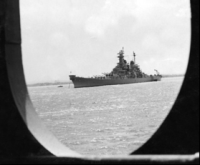 Spending most of 1961 in the Philadelphia Naval Shipyard undergoing a FRAM (fleet rehabilitation and modernization) overhaul, Roberts returned to Newport on 26 February 1962 and remained in the western Atlantic for the rest of 1962 and most of 1963. During April and June of the latter year, she operated off the northern New England coast in search of the missing submarine, USS Thresher (SSN-593). In the latter part of the year, the ship was called on to be part of the blockade of Cuba during the Cuban Missile Crisis.
Spending most of 1961 in the Philadelphia Naval Shipyard undergoing a FRAM (fleet rehabilitation and modernization) overhaul, Roberts returned to Newport on 26 February 1962 and remained in the western Atlantic for the rest of 1962 and most of 1963. During April and June of the latter year, she operated off the northern New England coast in search of the missing submarine, USS Thresher (SSN-593). In the latter part of the year, the ship was called on to be part of the blockade of Cuba during the Cuban Missile Crisis.
In October 1963, Roberts resumed overseas operations and, for the next two years, rotated between duty in the western Atlantic and tours with the 6th Fleet. Then, in the fall of 1965, she was called on to transit the Panama Canal and move into the western Pacific to join the 7th Fleet. The ship operated primarily in Vietnamese and Philippine waters until 19 February 1966.
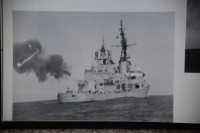
On 19 February 1966, the ship steamed for home via the Suez Canal and the Mediterranean Sea. She returned to a “heroes welcome” at Newport, R.I. on 8 April, 1966. For the balance of the year, Roberts cruised in the Atlantic and Caribbean until once again deploying to the Mediterranean on 8 December.
Samuel B Roberts returned to Newport on 20 March 1967 and remained in Atlantic and Caribbean waters from that time until 10 January 1968 when she sailed on another tour of Mediterranean duty. Return to Newport was on the 17th of May. It was back to Atlantic operations for the balance of the year. She continued operating thusly until deploying to the Mediterranean on 22 November 1969. She steamed the Black Sea from 9 to 12 December and returned to Newport on 22 May 1970.
The Beginning of the End
While tied up to the tender in Naples during the above cruise, Roberts was crashed into by a runaway freighter. The event resulted in extensive damage to Roberts and although she was repaired and continued her assignment, it is probable the incident precipitated what was to come.
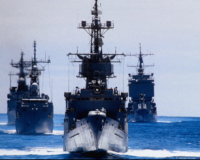 In August 1970, Samuel B Roberts underwent Inspection and Survey. The inspection team determined the ship to be unfit for further Naval service. Accordingly, on 2 November, she was decommissioned and her name was struck from the Navy list. She then joined the Inactive fleet at Philadelphia, Pa. and remained there until sunk as a target off the coast of Puerto Rico on 14 November 1971.
In August 1970, Samuel B Roberts underwent Inspection and Survey. The inspection team determined the ship to be unfit for further Naval service. Accordingly, on 2 November, she was decommissioned and her name was struck from the Navy list. She then joined the Inactive fleet at Philadelphia, Pa. and remained there until sunk as a target off the coast of Puerto Rico on 14 November 1971.
